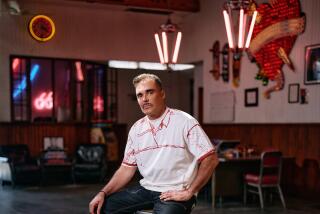Benjamen Chinn dies at 87; photographer documented San Francisco’s Chinatown
- Share via
Benjamen Chinn, one of the few Chinese American photographers to live and artfully document street scenes in San Francisco’s Chinatown, has died. He was 87.
Chinn died April 25 at Kaiser Permanente San Francisco Medical Center, according to Newton Don, his nephew who is the executor of his estate. He was being treated for an infection and died of cardiac arrest.
Often photographing from the doorway of his home in Chinatown, Chinn began training his camera on his neighborhood in the late 1930s, but his most productive years were from 1947-1949 while he was studying at what is now the San Francisco Art Institute.
FOR THE RECORD:
Chinn obituary: The obituary of San Francisco photographer Benjamen Chinn in Monday’s Section A failed to include his sister, Anne Chin Jue, among his survivors. —
“Rarely has Chinatown been photographed skillfully, for the sake of art, by one of its own residents -- by someone who knows Chinatown up close, as the site of home and work and day-to-day life,” Dennis J. Reed, dean of Fine, Performing and Media Arts at L.A. Valley College, wrote in the book “Asian Art in America.”
According to Reed, “Chinn’s photographs artfully explore the dignity of Chinatown’s residents, the differences between the generations of old and new Chinese, and the coexistence of interweaving of Chinese and American cultures.”
In the early 1950s, Chinn moved to Paris and photographed street life while studying art at the Academie Julian where he took sculpture classes from Alberto Giacometti. He also took painting classes at Fernand Leger’s studio as well as geography and philosophy courses at the Sorbonne.
He found little work in Europe and moved back to San Francisco in 1952. Chinn took a job with the U.S. 6th Army Photo Lab in the Presidio of San Francisco where he had a 31-year career, rising to the post of chief of photographic services and, later, chief of training aids and services division.
For such an accomplished photographer, the work of the quiet and self-effacing Chinn had comparatively little public exposure during his lifetime. Minor White, a great photographer in his own right, included some of it in an exhibition called “Perceptions” at the San Francisco Museum of Art in 1954. It was not until 2003 that Chinn received a major solo exhibition at the Chinese Historical Society of San Francisco.
Chinn was born on Commercial Street in San Francisco’s Chinatown on April 30, 1921. One of 12 children, he was just 10 when an older brother taught him some fundamentals of photography, and he took to it immediately. During World War II, he used his photography skills while serving as an aerial, ground and public relations photographer in the Army Air Forces while stationed in Hawaii.
After the war, he returned home and, using the GI Bill, enrolled in a photography course at the California School of Fine Arts, one of the first colleges to include photography in its art curriculum. His first teacher was Ansel Adams, who founded the school’s photography program, but Chinn also studied with White, who became his artistic light as a teacher.
The school offered an impressive atmosphere for budding students. Lecturers included such noted photographers as Imogen Cunningham, Dorothea Lange and Lisette Model.
According to his nephew, the highlight of each school year was a weeklong trip to Edward Weston’s home in Carmel, when the photographer would lead walks through Point Lobos and give lectures on photography.
The sense of community and friendship prevailed over the years. Chinn and Cunningham became good friends, and he often took dim sum to her San Francisco home for lunch.
In addition to photography, Chinn also studied with the painters Richard Diebenkorn and Dorr Bothwell. Chinn would credit them with helping him shape his sense of spatial organization in his photographs.
Chinn was precise and exacting in printing his own photographs. While living in San Francisco he had his own dark room, but during his Paris years he had no access to printing facilities. That body of work is just now being uncovered by his nephew and other members of his family.
He quit taking fine art photographs after his return from Paris because he “said he didn’t think anyone wanted to look at them,” his nephew said.
While working for the Army after his return from Paris, Chinn taught printing techniques to Paul Caponigro, then an enlisted man who became a substantial landscape art photographer.
“Ben’s own talent and ability with the camera coupled with his willingness to reach out to another human being gave me a great start and the inspiration to extend myself to those searching to develop within the realm of great art,” Caponigro said several years ago.
Chinn’s passion for observation continued through much of his life. He traveled to Mexico, visiting the Tarahumara Indians in Copper Canyon, Mexico, and the indigenous people of Teotitlan.
For a time after his retirement in 1984, he volunteered at a neighborhood photo store in Chinatown, operating a machine that developed photos in an hour.
He lived in Chinatown until February 2008, when his failing health necessitated a move to an assisted-living facility outside the district.
Survivors include his brothers, Martin and Thomas, and their extended families.
More to Read
Start your day right
Sign up for Essential California for the L.A. Times biggest news, features and recommendations in your inbox six days a week.
You may occasionally receive promotional content from the Los Angeles Times.






